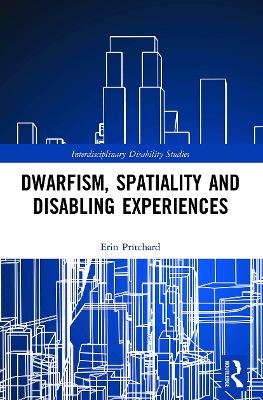
Dwarfism, Spatiality and Disabling Experiences
Seiten
2022
Routledge (Verlag)
978-0-367-64430-7 (ISBN)
Routledge (Verlag)
978-0-367-64430-7 (ISBN)
This book provides an in-depth analysis of the social and spatial experiences of people with dwarfism, an impairment that results in a person being no taller than 4ft 10.
This book provides an in-depth analysis of the social and spatial experiences of people with dwarfism, an impairment that results in a person being no taller than 4' 10".
This book engages with the concept that dwarfism’s most prominent feature – body size and shape – can form the basis of social discrimination and disadvantages within society. By ignoring body size as a disability, it is hard to see the resulting disabling consequences of the built environment. Using a mixed-methods approach and drawing on the work undertaken by human geographers and disability studies academics, this book analyses how the relationship between harmful cultural stereotypes and space shapes everyday experiences of people with dwarfism and works to socially exclude them in diverse ways. Showing how spatial and social barriers are not mutually exclusive but can influence one another, this book responds to the limited academic work on the subject of dwarfism, whilst also contributing to the study of geographies of body size.
It will be of interest to all scholars and students of disability studies, human geography, the built environment, sociology and medical humanities.
This book provides an in-depth analysis of the social and spatial experiences of people with dwarfism, an impairment that results in a person being no taller than 4' 10".
This book engages with the concept that dwarfism’s most prominent feature – body size and shape – can form the basis of social discrimination and disadvantages within society. By ignoring body size as a disability, it is hard to see the resulting disabling consequences of the built environment. Using a mixed-methods approach and drawing on the work undertaken by human geographers and disability studies academics, this book analyses how the relationship between harmful cultural stereotypes and space shapes everyday experiences of people with dwarfism and works to socially exclude them in diverse ways. Showing how spatial and social barriers are not mutually exclusive but can influence one another, this book responds to the limited academic work on the subject of dwarfism, whilst also contributing to the study of geographies of body size.
It will be of interest to all scholars and students of disability studies, human geography, the built environment, sociology and medical humanities.
Erin Pritchard is a lecturer in Disability and Education in the School of Social Sciences at Liverpool Hope University, UK.
Chapter 1 – Introduction.
Chapter 2 – Access Tall Spaces.
Chapter 3 – Resisting Spaces.
Chapter 4 – Disabling Identities.
Chapter 5 – Cultural Representations of People with Dwarfism and the Social Consequences.
Chapter 6 – Conclusion: The Politics of Space, Identity and the Sized Body.
| Erscheinungsdatum | 12.05.2022 |
|---|---|
| Reihe/Serie | Interdisciplinary Disability Studies |
| Zusatzinfo | 1 Illustrations, black and white |
| Verlagsort | London |
| Sprache | englisch |
| Maße | 156 x 234 mm |
| Gewicht | 453 g |
| Themenwelt | Sachbuch/Ratgeber ► Gesundheit / Leben / Psychologie ► Lebenshilfe / Lebensführung |
| Studium ► Querschnittsbereiche ► Prävention / Gesundheitsförderung | |
| Naturwissenschaften ► Biologie ► Ökologie / Naturschutz | |
| Naturwissenschaften ► Geowissenschaften ► Geografie / Kartografie | |
| Sozialwissenschaften ► Soziologie | |
| ISBN-10 | 0-367-64430-4 / 0367644304 |
| ISBN-13 | 978-0-367-64430-7 / 9780367644307 |
| Zustand | Neuware |
| Haben Sie eine Frage zum Produkt? |
Mehr entdecken
aus dem Bereich
aus dem Bereich
Orthomolekulare Medizin in Prävention, Diagnostik und Therapie
Buch | Hardcover (2022)
Thieme (Verlag)
71,00 €
Lehrbuch zur berufsspezifischen Ausbildung
Buch | Softcover (2021)
Kohlhammer (Verlag)
46,00 €


